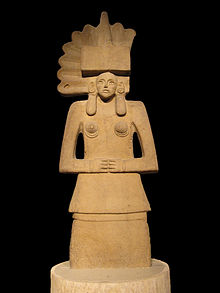
Aztec mythology is the body or collection of myths of the Aztec civilization of Central Mexico. The Aztecs were Nahuatl-speaking groups living in central Mexico and much of their mythology is similar to that of other Mesoamerican cultures. According to legend, the various groups who became the Aztecs arrived from the North into the Anahuac valley around Lake Texcoco. The location of this valley and lake of destination is clear – it is the heart of modern Mexico City – but little can be known with certainty about the origin of the Aztec. There are different accounts of their origin. In the myth, the ancestors of the Mexica/Aztec came from a place in the north called Aztlan, the last of seven nahuatlacas to make the journey southward, hence their name "Azteca." Other accounts cite their origin in Chicomoztoc, "the place of the seven caves", or at Tamoanchan.

Ehecatl is a pre-Columbian deity associated with the wind, who features in Aztec mythology and the mythologies of other cultures from the central Mexico region of Mesoamerica. He is most usually interpreted as the aspect of the Feathered Serpent deity as a god of wind, and is therefore also known as Ehecatl-Quetzalcoatl. Ehecatl also figures prominently as one of the creator gods and culture heroes in the mythical creation accounts documented for pre-Columbian central Mexican cultures.
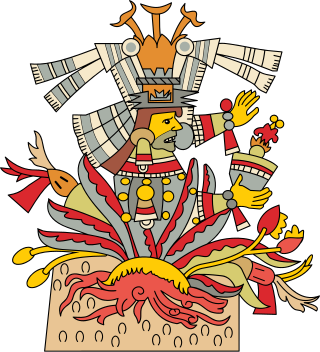
Mayahuel is the female deity associated with the maguey plant among cultures of central Mexico in the Postclassic era of pre-Columbian Mesoamerican chronology, and in particular of the Aztec cultures. As the personification of the maguey plant, Mayahuel is also part of a complex of interrelated maternal and fertility goddesses in Aztec religion and is also connected with notions of fecundity and nourishment.

In Aztec mythology, Xochiquetzal, also called Ichpochtli Classical Nahuatl: Ichpōchtli, meaning "maiden"), was a goddess associated with fertility, beauty, and love, serving as a protector of young mothers and a patroness of pregnancy, childbirth, and the crafts practiced by women such as weaving and embroidery. In pre-Hispanic Maya culture, a similar figure is Goddess I.

Chalchiuhtlicue is an Aztec deity of water, rivers, seas, streams, storms, and baptism. Chalchiuhtlicue is associated with fertility, and she is the patroness of childbirth. Chalchiuhtlicue was highly revered in Aztec culture at the time of the Spanish conquest, and she was an important deity figure in the Postclassic Aztec realm of central Mexico. Chalchiuhtlicue belongs to a larger group of Aztec rain gods, and she is closely related to another Aztec water god called Chalchiuhtlatonal.
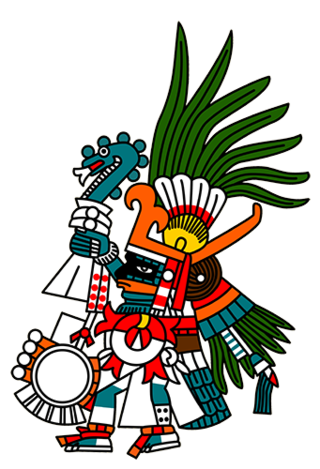
Huitzilopochtli is the solar and war deity of sacrifice in Aztec religion. He was also the patron god of the Aztecs and their capital city, Tenochtitlan. He wielded Xiuhcoatl, the fire serpent, as a weapon, thus also associating Huitzilopochtli with fire.
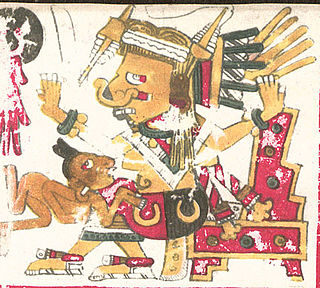
In Aztec mythology, Tlahzōlteōtl is a deity of sexuality, vice, purification, steam baths, lust, filth, and a patroness of adulterers. She is known by three names, Tlahēlcuāni and Tlazōlmiquiztli, and Ixcuina or Ixcuinan, the latter of which refers to a quadripartite association of four sister deities.

Cihuacōātl was one of a number of motherhood and fertility goddesses in Aztec mythology. She was sometimes known as Quilaztli.

Huehueteotl is an aged Mesoamerican deity figuring in the pantheons of pre-Columbian cultures, particularly in Aztec mythology and others of the Central Mexico region. The spellings Huehuetéotl and Ueueteotl are also used. Although known mostly in the cultures of that region, images and iconography depicting Huehueteotl have been found at other archaeological sites across Mesoamerica, such as in the Gulf region, western Mexico, Protoclassic-era sites in the Guatemalan highlands such as Kaminaljuyú and Late-Postclassic sites on the northern Yucatán Peninsula. The name Huehueteotl stems from Nahuatl huēhueh ("old") and teōtl ("god"). It seems to connect the Old God to certain Mayan deities called Mam ("Grandfather").
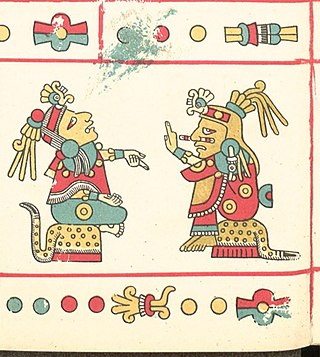
Ōmeteōtl is a name used to refer to the pair of Aztec deities Ometecuhtli and Omecihuatl, also known as Tōnacātēcuhtli and Tonacacihuatl. Ōme translates as "two" or "dual" in Nahuatl and teōtl translates as "phenomena". The existence of such a concept and its significance is a matter of dispute among scholars of Mesoamerican religion. Ometeotl was one as the first divinity, and Ometecuhtli and Omecihuatl when the being became two to be able to reproduce all creation.

Tlālōcān is described in several Aztec codices as a paradise, ruled over by the rain deity Tlāloc and his consort Chalchiuhtlicue. It absorbed those who died through drowning or lightning, or as a consequence of diseases associated with the rain deity. Tlālōcān has also been recognized in certain wall paintings of the much earlier Teotihuacan culture. Among modern Nahua-speaking peoples of the Gulf Coast, Tlālōcān survives as an all-encompassing concept embracing the subterranean world and its denizens.

Tlaltecuhtli is a pre-Columbian Mesoamerican deity worshipped primarily by the Mexica (Aztec) people. Sometimes referred to as the "earth monster," Tlaltecuhtli's dismembered body was the basis for the world in the Aztec creation story of the fifth and final cosmos. In carvings, Tlaltecuhtli is often depicted as an anthropomorphic being with splayed arms and legs. Considered the source of all living things, she had to be kept sated by human sacrifices which would ensure the continued order of the world.

In Aztec mythology, Tōnacācihuātl was a creator and goddess of fertility, worshiped for peopling the earth and making it fruitful. Most Colonial-era manuscripts equate her with Ōmecihuātl. Tōnacācihuātl was the consort of Tōnacātēcuhtli. She is also referred to as Ilhuicacihuātl or "Heavenly Lady."

Ixchel or Ix Chel is the 16th-century name of the aged jaguar goddess of midwifery and medicine in ancient Maya culture.

Tamōhuānchān is a mythical location of origin known to the Mesoamerican cultures of the central Mexican region in the Late Postclassic period. In the mythological traditions and creation accounts of Late Postclassic peoples such as the Aztec, Tamoanchan was conceived as a paradise where the gods created the first of the present human race out of sacrificed blood and ground human bones which had been stolen from the Underworld of Mictlan.

Itzcoatl was the fourth king of Tenochtitlan, and the founder of the Aztec Empire, ruling from 1427 to 1440. Under Itzcoatl the Mexica of Tenochtitlan threw off the domination of the Tepanecs and established the Triple Alliance together with the other city-states Tetzcoco and Tlacopan.
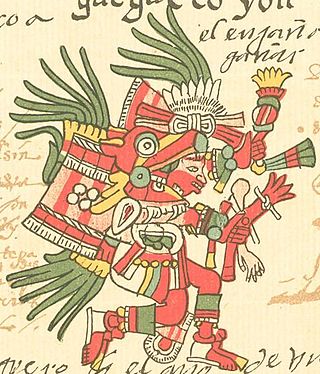
In Aztec mythology, Huēhuehcoyōtl is the auspicious Pre-Columbian god of music, dance, mischief, and song. He is the patron of uninhibited sexuality and rules over the day sign in the Aztec calendar named cuetzpallin (lizard) and the fourth trecena Xochitl.

In Aztec mythology, Ometochtli is the collective or generic name of various individual deities and supernatural figures associated with pulque, an alcoholic beverage derived from the fermented sap of the maguey plant. By the Late Postclassic period of Mesoamerican chronology a collection of beliefs and religious practices had arisen in the context of the manufacture and ritualistic consumption of the beverage, known as the "pulque cult" with probable origins in a mountainous region of central Mexico. In Aztec society octli rituals formed a major component of Aztec religion and observance, and there were numerous local deities and classes of sacerdotes ("priests") associated with it.
Omeyocan is the highest of thirteen heavens in Aztec mythology, the dwelling place of Ometeotl, the dual god comprising Ometecuhtli and Omecihuatl.
